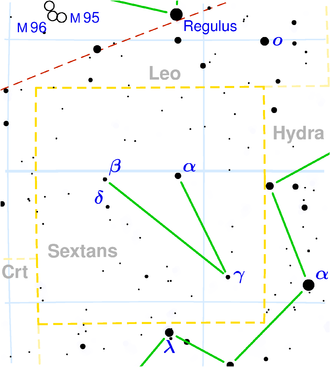NGC 2974
| Galaxy NGC 2974 |
|
|---|---|

|
|
| AladinLite | |
| Constellation | sextant |
|
Position equinox : J2000.0 , epoch : J2000.0 |
|
| Right ascension | 09 h 42 m 33.3 s |
| declination | -03 ° 41 ′ 57 ″ |
| Appearance | |
| Morphological type | E4 / Sy2 / LINER |
| Brightness (visual) | 10.9 likes |
| Brightness (B-band) | 11.9 likes |
| Angular expansion | 3.5 ′ × 2 ′ |
| Position angle | 40 ° |
| Surface brightness | 13.1 mag / arcmin² |
| Physical data | |
| Affiliation | NGC 2974 group LGG 179 |
| Redshift | 0.006294 ± 0.000017 |
| Radial velocity | 1887 ± 5 km / s |
|
Stroke distance v rad / H 0 |
(77 ± 6) · 10 6 ly (23.6 ± 1.7) Mpc |
| history | |
| discovery | William Herschel |
| Discovery date | January 6, 1785 |
| Catalog names | |
| NGC 2974 • UGCA 172 • PGC 27762 • CGCG 007-022 • MCG + 00-25-008 • IRAS 09400-0328 • 2MASX J09423326-0341568 • GC 1904 • H I 61 • h 630 • GALEX ASC J094233.20-034153.7 | |
NGC 2974 is an elliptical galaxy with an active nucleus of the Hubble type E4 in the constellation Sextant in the southern sky . It is an estimated 77 million light-years away from the Milky Way and has a diameter of about 80,000 ly.
The object was discovered by William Herschel on January 6, 1785 . It was rediscovered in 1886 by Ormond Stone , who was listed in the NGC catalog as 2652 .
Web links
Commons : NGC 2974 - collection of images, videos, and audio files
